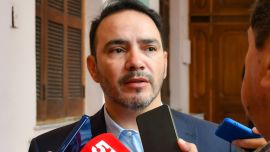Nature abhors a vacuum, as a saying going 24 centuries back to Aristotle tells us, but Argentina today is stuck in that unnatural territory and will be for weeks to come. With multiple scenarios lurking in an uncertain future, what can the past tell us as to what to expect?
The current twilight zone between last month’s PASO primary and next month’s actual midterm voting has few enough direct parallels in Argentine experience – only previously occurring in 2013 and 2017 (with the presidential elections of 2011, 2015 and 2019 likewise preceded by PASO primaries a couple of months beforehand). And given that the 2017 PASO gave the Mauricio Macri presidency scant cause for concern (ex-president Cristina Fernández de Kirchner’s 0.21 percent edge in Buenos Aires Province senatorial voting turned out to be just as vulnerable as it looked), this basically offers 2013 as the only direct precedent for a government regrouping in the face of an electoral defeat foretold.
Nevertheless, rolling back the clock as far as 1930 (which I cannot claim to lie within my personal memory span), there are some uncanny overlaps with the current situation. The percentage plunge from a presidential triumph two years previously was strikingly similar then and now. Elected by a 61.7 percent landslide in 1928, Radical President Hipólito Yrigoyen barely squeaked through the March midterms of 1930 with 43.2 percent of the vote while by the time of the coup six months later the Buenos Aires Herald of those days estimated his support to be down to a third of his original strength (which seems a pretty educated guess in the absence of opinion polls back then). Almost two years ago now Alberto Fernández was elected president with 48.24 of the vote, only for his Frente de Todos to net a miserable 30.9 percent last month – the falls of 18.5 and 17.3 percent for Yrigoyen and Fernández respectively represent broadly similar dimensions of collapse. A further parallel between the two men would be the wheels coming off their presidencies against the backdrop of global catastrophe in the form of the Great Depression of 1929 and the coronavirus pandemic respectively (even if it would be something of a stretch to blame the presidential demise entirely on international disaster in either case).
Yet here the similarities start to run dry – the chances of the current quandary culminating in a military coup seem even remoter than Florencio Randazzo winning next month in Buenos Aires Province. But the alarmism is not totally exaggerated – the huge differences with 1930 should not blind us to a very real danger of finding ourselves at the edge of a precipice with an equally steep plunge into the unknown.
Too many more military coups and abbreviated presidencies in the half-century following 1930 to give us much in the way of comparative midterm experience to now. The next midterm trauma came in 1987 (held on the 57th anniversary of the coup against the Radical Yrigoyen) – the joke of the day “What does UCR stand for? Unicamente Córdoba y Ríonegro (the only provinces where they won)” is as good a way of summing up the shattering Radical defeat as any. But whereas the gap between last month’s PASO and next month’s midterms is just nine weeks, fully 118 weeks lay between the 1987 voting and the scheduled end of the Raúl Alfonsín presidency (eventually brought forward five months by hyperinflation). Alfonsín’s successor Carlos Menem was never really bothered by midterm blues and if the 1997 voting went badly (the opposition Alliance notched up a double-digit margin with almost 47 percent of the vote), that was his heir-apparent Eduardo Duhalde’s problem, not his.
The next midterms on the other side of the turn of the century in 2001 rebounded against the Alliance (even if not quite as disastrous as 1987, winning in just six provinces) and in this case the fallout from defeat was almost immediate – the Fernando de la Rúa presidency lasted less than 10 more weeks while the run on the banks span out of any orthodox control within six weeks of the electoral debacle. The only other pre-PASO midterm setback of this century was precisely the one which led to the creation of PASO – 2009 when ex-president Néstor Kirchner was humiliatingly defeated by two percent in the Peronist stronghold of Buenos Aires Province, largely because Martín Sabbatella’s allied list garnered almost six percent of the vote (the whole purpose of creating PASO primaries was thus to weed out such friendly fire ahead of the real voting).
Which brings us to the most direct comparison with the fallout from a midterm setback – 2013 (perceived as a defeat because of a second consecutive midterm loss in Buenos Aires Province although the Victory Front won in a dozen other districts). The government reflexes then and now have at least one thing in common – the Cabinet chief was dumped in favour of a northern governor, Chaco’s Jorge Capitanich in 2013 and Tucumán’s Juan Manzur now. Capitanich entered the scene with a hyperactive swagger much like Manzur now, only to gradually fade into the background. But here the similarities start to end. Whereas now both President Fernández and his powerful veep have temporarily abdicated in their different ways in order for Manzur to take the rap for a likely defeat, then-president Cristina Fernández de Kirchner in 2013 tightened her stranglehold on power yet further in the very visible form of promoting today’s Buenos Aires Province Governor Axel Kicillof to economy minister for even more drastic state intervention. The contrast with today’s Economy Minister Martín Guzmán could hardly be greater – while Kicillof plunged recklessly ahead, Guzmán is in no man’s land, assailed over both his 2022 Budget from multiple angles and his failure to run up the full deficit of this year’s budget but yet with no clear sign that he is on the way out either.
But the big difference between now and both 2009 and 2013 (and 2015 for that matter) is that while the governments then seemed to take defeat in their stride, swallow hard and then concentrate on the next presidential elections, Frente de Todos seems to be burning all its boats in a frantic bid to turn around next month’s midterms in total disregard of the consequences for the 2023 general elections. But perhaps this eccentric strategy of abdicating power in order to perpetuate it can only be expected from a presidential ticket where the tail always wagged the dog.



















Comments